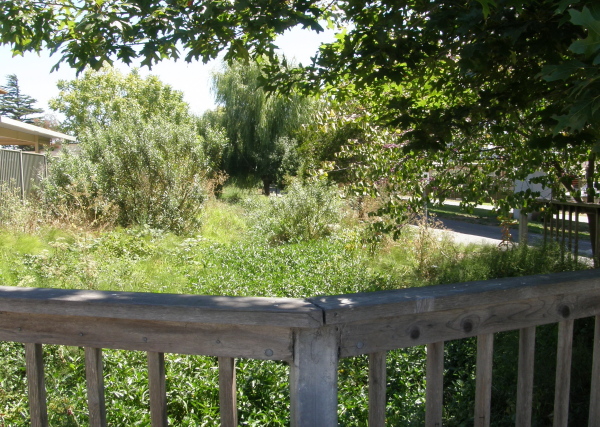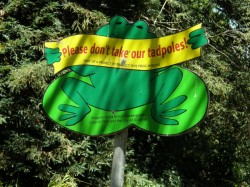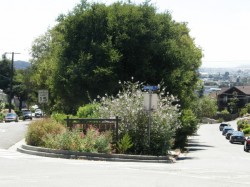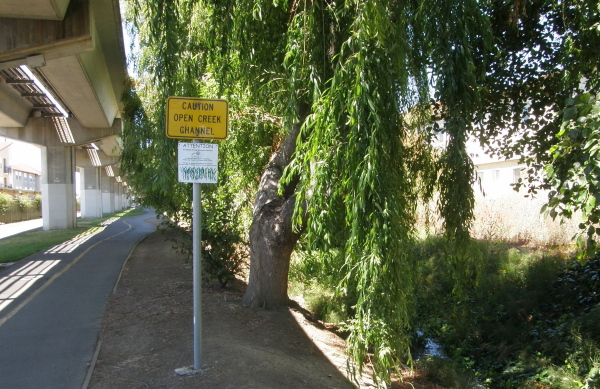El Cerrito: Four Creek Projects
Canyon Trails Park, Conlon Ave. & Fern St.; Poinsett Park, Edwards and Poinsett Aves.; Cerrito Creek, south edge El Cerrito Plaza, Talbot to Kains; all El Cerrito
Map
Restoration or revitalization of creeks in parks or other public areas often aims at reducing flooding or erosion, improving habitat for wildlife, or simply making the area more attractive. Volunteer effort or public interest is often a catalyst. These projects can reduce urban-runoff problems even though that is not their main purpose. Such projects can be found throughout the Bay Area. Here are four examples from the small city of El Cerrito.
Canyon Trails Park: Local residents and school children transformed what a bare concrete pond on little Baxter Creek. Interest centered on native Pacific Chorus frogs and Native American petroglyphs on the large rock at left. Although the impervious concrete bottom remains, tules and cattails in the pond trap pollutants as well as sheltering frog eggs and tadpoles.
Poinsett Park: Narrow Poinsett Park was a narrow grass strip with Baxter Creek buried in a pipe. In 1996 the city opted to “daylight” the creek rather than replace the failing pipe. By creating step pools and a somewhat meandering channel (Report), storm flows were slowed, lessening erosion and flooding downstream. The naturalized channel also lets water soak into soil.
Planted native trees and brush now all but hide the little creek. These woody plants have many environmental benefits, but they do little to trap and filter pollutants.
If this project were designed now, curbs might be cut to channel street runoff into the park.
Ohlone Greenway between Portola and Schmidt: A small unnamed creek flowing from Arlington Park in the El Cerrito Hills had been channeled into a storm drain next to the Ohlone Greenway, a popular pedestrian/bicycle trail under the BART tracks. In 1996, again because the pipe was failing, the city “daylighted” a segment of creek, creating a block-long north-south channel where none had existed naturally.

This project lacks underdrains, special permeable soils, high-flow overflow pipes, and other refinements of more recent swales. Nevertheless, it slows storm flows and allows rain to soak into soil, while its water weeds filter and trap pollutants.
Cerrito Creek at El Cerrito Plaza: Cerrito Creek edging El Cerrito Plaza had been strait-jacketed into a partly concrete ditch (below left). Oil, gas, and heavy metals from the parking lot washed straight to the creek.
 A 2001 restoration supported by volunteers, Coastal Conservancy funds, and the City of El Cerrito moved the parking lot back to create a creekside trail along a naturalized channel.
A 2001 restoration supported by volunteers, Coastal Conservancy funds, and the City of El Cerrito moved the parking lot back to create a creekside trail along a naturalized channel.
As the photo below shows, the creek, hidden by trees at left, now is buffered from parking-lot pollution. The slightly meandering, rough channel slows storm flows to some degree. Water can soak into soil. Cattails and watercress provide some pollutant removal where they are not shaded out.
The permeable trail shown in the photo below has been replaced by impermeable decomposed granits. Made using “cullet,” bits left over from glass recycling, held in place by recycled-plastic cells, it must be considered a failure in this public setting. The glass frightened some people. Wheelchairs bogged down when the glass was deep enough to cover recycled-plastic cells aimed a holding a base for the trail. Thinning the glass exposed the cells, which then were easily kicked loose, creating a hazard.





